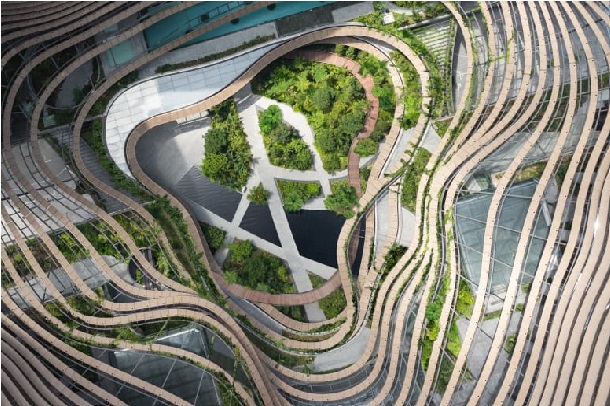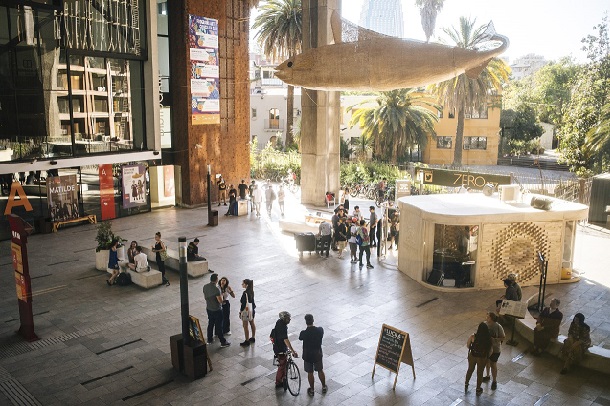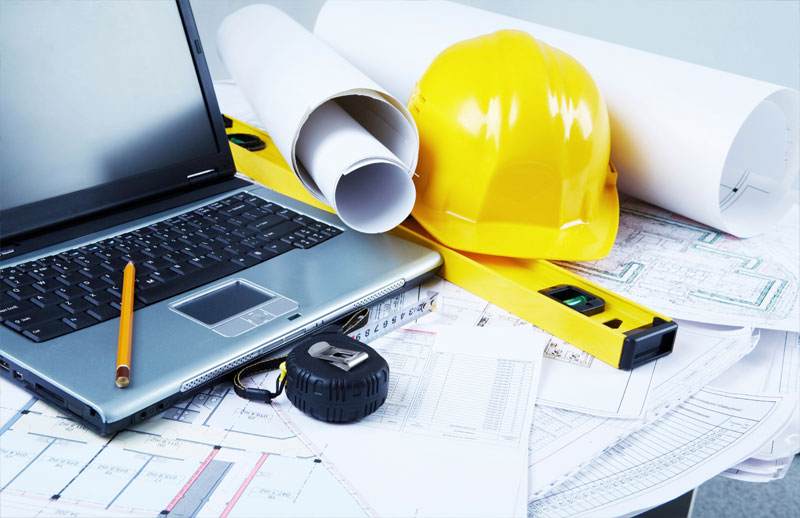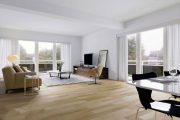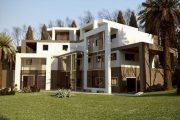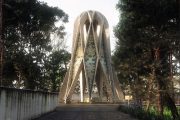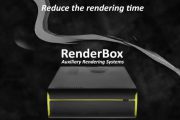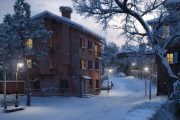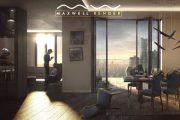ساختمان مبل لمکده در یک بافت متراکم، یکدست و تخت، و در مجاورت اتوبان رسالت، یکی از پرترددترین اتوبانهای تهران، قرار دارد. ساختمان موجود، عمری ۳۰ ساله داشت که نمای آن از تراورتنهای افقی سفیدرنگ پوشیده شده بود. مشتری در ابتدا، با نشان دادن نمونههایی از ساختمانهای اداری ـ تجاری در تهران که عمدتا نمای کامپوزیت و دوبعدی دارند، درخواست چنین نمایی داشت. اما با بازدید از محل و درک پتانسیلهای آن، پیشنهاد ما در همان ابتدا، نظر او را تغییر داد.

تهران شهری است با بافتی متراکم که تیپولوژی عمده آن ساختمانهای ۴ تا ۵ طبقه است. در چنین بافت یکدستی و با توجه به عمده محدودیتهای موجود، اعم از قوانین شهرداری، بودجه و اقتصاد، نمای ساختمانها میتواند به موضوعی قابل توجه برای معماری ما تبدیل شود. برای ما، پوسته پوششدهنده فقط به عنوان یک سطح مطرح نیست، بلکه فضایی است که تحت تاثیر ساخت، مقیاس، ابعاد فضای پوشش، نفوذپذیری و میزان سایهاندازی قرار میگیرد و میتواند به شکل عنصری تاثیرگذار، جایگزین صفحه خالی در بدنه شهری شود.
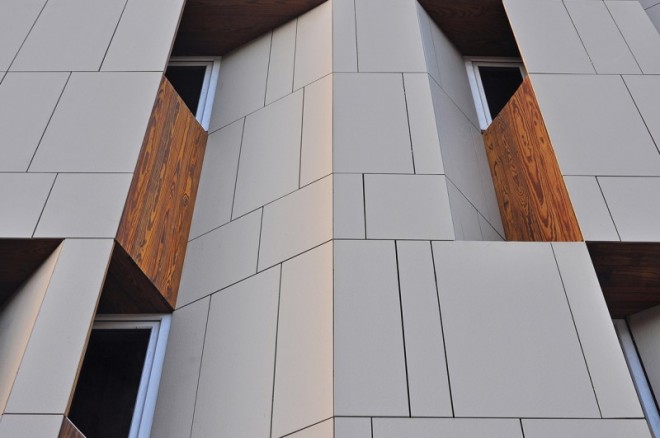
با توجه به پتانسیل ایجاد عمق تا ۴۰ سانتیمتر، چگونگی ارتباط میان سطح و عمق، هدف اصلی این پروژه است. این ارتباط چگونه میتواند بر روی بینندهای که با سرعت، در حال عبور از بزرگراه است، تاثیر بگذارد؟ و این تاثیر چگونه میتواند در او یک تصویر ذهنی ایجاد کند؟ یک تصویر ـ خاطره. ایجاد تضاد یکپارچه میان سطح و عمق، میان روشن و تیره، میان صیقلی و زبر، میان طبیعی و مصنوعی، راهکار ایجاد این تاثیر است؛ تداعی دوگانهای که میتواند یک پس ـ تصویر در ذهن ایجاد کند. اینجاست که نما میتواند به یک عامل اثرگذار تبدیل شود.
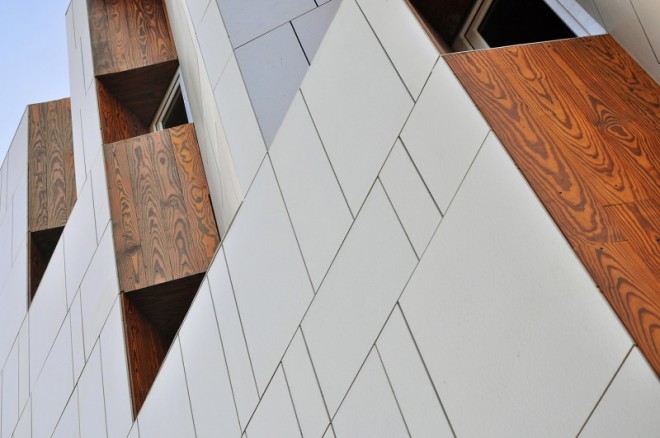
پروژه با تحلیل شبکه نمای موجود در بافت پروژه و تبدیل آن به یک شبکه سهبعدی جدید شکل گرفت. الگوی رندوم استفاده شده در سطح، بر شدت احساس بصری و کنتراست با عمق میافزاید، “احساسی که از یک نظم به نظمی دیگر، از یک سطح به سطحی دیگر و از منطقه ای به منطقه دیگر میرود.” (فرانسیس بیکن) متریال استفاده شده برای این پروژه، سرامیک سفید برای سطوح و چوب طبیعی برای عمقها است. برای کاهش وزن نما، متریال به شکل خشکهچینی و از طریق زیرساز آلومینیومی، به سازه فلزی موجود متصل شده است.
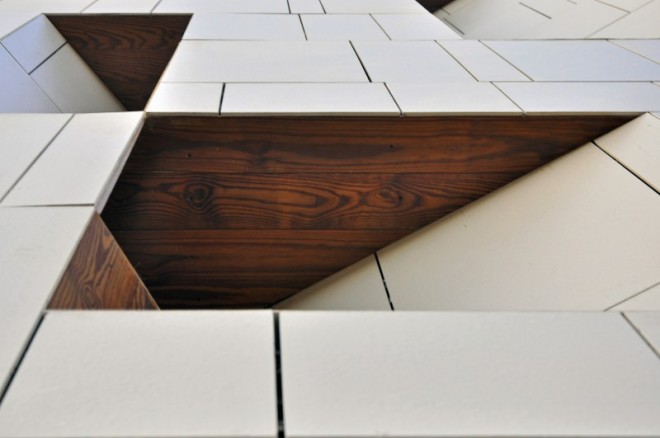
ساختمان مبل لمکده :
معمار: دفتر کاما (ایمان شفیعی، بهزاد منشگر)
موقعیت: تهران، ایران
تاریخ: ۱۳۹۲
مساحت: ۱۱۲ مترمربع
وضعیت: ساختهشده
کارفرما: آقای مسعود دولتنیا
تیم طراحی: ایمان شفیعی، بهزاد منشگر، با همکاری غزال گودرزنیا و سمانه ساداتمیر
همکاران اجرایی: مجید غیاثوند، حمید امامی، ایمان زارع
عکس: مسیح مستاجران، حکیم حمادی
ﺟﻮاﻳﺰ: رﺗﺒﻪ دوم ﮔﺮوه بازسازی جایزه ﻣﻌﻤﺎر ۱۳۹۲
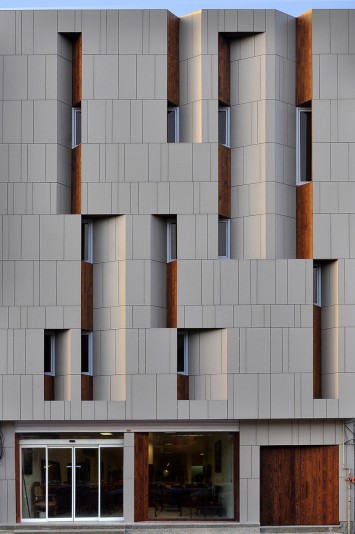

عکس های بیشتر
English version :
Lamkadeh Furniture Building
PROJECT GENERAL INFORMATION Name: Lamkadeh Furniture Building Location: Tehran, Iran Architects: Office Comma | Iman Shafiee, Behzad Maneshgar Design Team: Ghazal Goodarznia and Samaneh Sadatmir Date: Spring- Summer 2013 Area: 112 sqm Type: Facade design, Renovation Executive Team: Majid Ghiasvand, Hamid Emami, Iman Zare Client: Masoud Dolatnia Photographs: Masih Mostajeran, Hakim Hemadi Awards: 2nd place (Shared) in Memar Grand Award, in the renovation category – 2013 With regard to the potential of making the depth to 40 cm, the relationship between the surface and the depth is the main objective of our project. How could this relationship influence a viewer who is driving fast in the highway? And how could this impact create a mental image in him/her? An image-memory. Making a consistent contrast between the surface and the depth, brightness and darkness, smooth and coarse, natural and artificial, is the way to make this impact; a bissociation which can create an afterimage in the mind. This is where the facade can become an effective factor. The project was formed by analyzing the network of the current facade in the project’s context and transforming it into a new three-dimensional network. Considering the project’s situation, during the day the building receives the sunlight from the southern side of the building and its northern side provides secondary light and a view to the highway. On this basis, the control of the view in the northern side of the building, which is our intervention area in the project, is considered as the strategy (inside to the outside). The random model used in the surface increases the intensity of the visual sense and the contrast with the depth; “the sensation which passes from one order to another, from one level to another, from one area to another” Francis Bacon. The overall structure is made based on the amount and manner of relationships and facade as the visual side of this structure reflects the inner life and the inner behaviors of the space. In this process, it is the total unity which becomes important and results in the consistency of the elements and things; exactly like the formation process of a Gabbeh.










